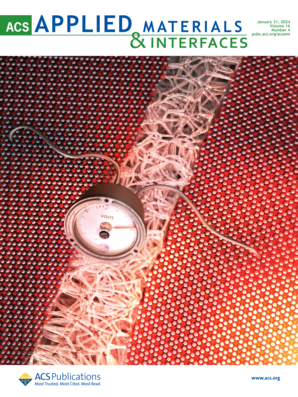Self-Powered and Self-Healing Underwater Sensors with Functions of Intelligent Drowning Warning and Rescuing by Using a Nonswelling Hydrogel
IF 8.3
2区 材料科学
Q1 MATERIALS SCIENCE, MULTIDISCIPLINARY
引用次数: 0
Abstract
Hydrogels have attracted increasing attention in wearable sensors, but preparing underwater hydrogel sensors with excellent anti-swelling and self-healing properties is still challenging. Herein, an anti-swelling and self-healing hydrogel is prepared by grafting poly(acrylic acid) with hydrophobic lauryl methacrylate, as well as constructing a second network and multiple molecular interactions (abbreviated as PALCF). The introduced hydrophobic long alkyl chains and the increased cross-linking density of the hydrogel result in a swelling ratio of only 0.04% after immersion in water for 15 days. Due to abundant metal coordination and hydrogen bonds, the PALCF hydrogel exhibits a high tensile stress of 0.60 MPa and a self-healing efficiency reaching 96.0% after self-healing at 60 °C for 2 min. Based on the piezoresistive effect, the PALCF hydrogel is directly used as an underwater strain sensor with a high sensitivity (GF = 2.24) to control underwater vehicles for rescue implementation. Furthermore, two self-powered triboelectric nanogenerator sensors with contact and non-contact models are constructed based on PALCF hydrogels for underwater communication, capable of sending out SOS messages and drowning alarms in emergency. The proposed underwater sensors with drowning warning and rescuing functions have the potential for use in drowning prevention, human–machine interfaces, and underwater communication system.

基于非膨胀水凝胶的自供电自修复水下智能溺水预警与救援传感器
水凝胶在可穿戴传感器中受到越来越多的关注,但制备具有优异抗膨胀和自愈性能的水下水凝胶传感器仍然具有挑战性。本文通过将聚丙烯酸与疏水性甲基丙烯酸十二酯接枝,构建第二网络和多个分子相互作用(简称PALCF),制备了一种抗膨胀、自愈的水凝胶。疏水长烷基链的引入和交联密度的增加使得水凝胶在水中浸泡15天后的溶胀率仅为0.04%。由于丰富的金属配位和氢键,PALCF水凝胶具有0.60 MPa的高拉伸应力,在60℃作用2 min后,自愈效率可达96.0%。基于压阻效应,PALCF水凝胶可直接作为高灵敏度(GF = 2.24)的水下应变传感器,控制水下机器人实施救援。此外,基于PALCF水凝胶,构建了两种接触式和非接触式自供电摩擦电纳米发电机传感器,用于水下通信,能够在紧急情况下发出SOS信息和溺水警报。所提出的具有溺水报警和救援功能的水下传感器在溺水预防、人机界面和水下通信系统中具有潜在的应用前景。
本文章由计算机程序翻译,如有差异,请以英文原文为准。
求助全文
约1分钟内获得全文
求助全文
来源期刊

ACS Applied Materials & Interfaces
工程技术-材料科学:综合
CiteScore
16.00
自引率
6.30%
发文量
4978
审稿时长
1.8 months
期刊介绍:
ACS Applied Materials & Interfaces is a leading interdisciplinary journal that brings together chemists, engineers, physicists, and biologists to explore the development and utilization of newly-discovered materials and interfacial processes for specific applications. Our journal has experienced remarkable growth since its establishment in 2009, both in terms of the number of articles published and the impact of the research showcased. We are proud to foster a truly global community, with the majority of published articles originating from outside the United States, reflecting the rapid growth of applied research worldwide.
 求助内容:
求助内容: 应助结果提醒方式:
应助结果提醒方式:


